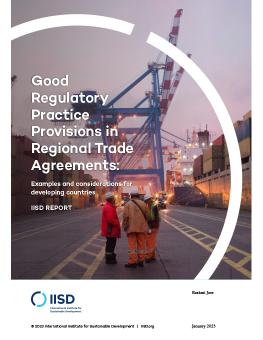
Good Regulatory Practice Provisions in Regional Trade Agreements
Examples and considerations for developing countries
Governments are increasingly negotiating rules on non-tariff barriers in their trade agreements, looking to address this significant source of trade costs. This paper looks at the U.S.-Mexico-Canada Agreement and the EU-Canada Comprehensive Economic and Trade Agreement to see how their respective approaches to good regulatory practices (GRPs)—a type of regulatory policy provision—and what developing countries and least developed countries should consider in their own trade negotiations.
As non-tariff barriers become an increasingly relevant source of trade costs, regulatory policy has become an important feature in trade negotiations and the trade policy agenda overall. This paper provides an overview of how stand-alone regulatory policy chapters are increasingly featured in recent regional trade agreements (RTAs). It then does an in-depth analysis of a specific type of regulatory policy provision—that of good regulatory practices (GRPs)—as these types of provisions are becoming more prolific and are being integrated into a more diverse range of agreements involving both developed and developing countries.
The paper analyzes how GRPs, especially those promoting stakeholder engagement, are evolving in select key RTAs, notably that of the United States–Mexico–Canada Agreement (USMCA) and the EU-Canada Comprehensive and Economic Trade Agreement (CETA). The paper concludes with key insights highlighting the policy implications for developing and least developed countries and proposes some considerations for policy thinking.
This material has been produced with funding from UK aid from the UK Government. Views expressed in the publication are the author’s own and do not necessarily reflect HM Government’s official positions.
Participating experts
You might also be interested in
Border Carbon Adjustments: Trinidad and Tobago country report
This report consolidates, analyzes, and presents views and perspectives of stakeholders from Trinidad and Tobago on border carbon adjustment (BCA) schemes to contribute to the global debate on BCA good practices.
Global Dialogue on Border Carbon Adjustments: The case of Brazil
This report consolidates, analyzes, and presents the views and perspectives of stakeholders from Brazil on border carbon adjustment (BCA) schemes to contribute to the global debate on BCA good practices.
Avoiding Trade Concerns in the Design of Plastic Pollution Measures
IISD provides insights on aspects of WTO members' plastics that have created friction with trading partners and suggests recommendations for the adoption of such policies in the future.
WTO Joint Initiative on E-Commerce State of Play
A finalized legal text of the e-commerce joint statement initiative agreement may be within reach: this report provides an overview of how close the participants are to the finish line and what remains to be agreed on.